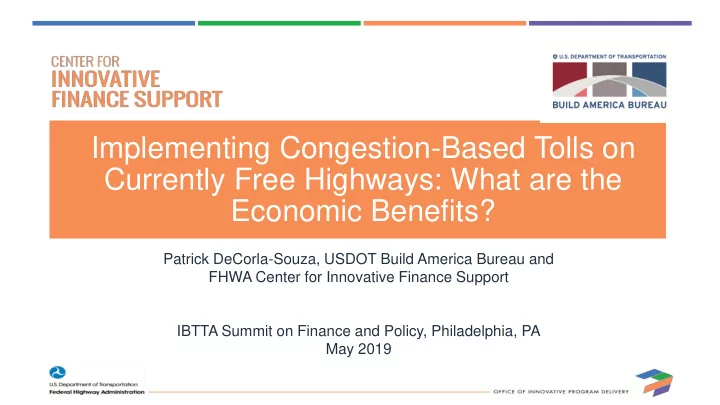

Implementing Congestion-Based Tolls on Currently Free Highways: What are the Economic Benefits? Patrick DeCorla-Souza, USDOT Build America Bureau and FHWA Center for Innovative Finance Support IBTTA Summit on Finance and Policy, Philadelphia, PA May 2019
Presentation Overview ▪ Hypothetical congestion pricing concept ▪ Evaluation tool ▪ Evaluation results 2
Hypothetical Congestion Pricing Concept 3
Example: I-66 Freeway in Northern Virginia ▪ Entire facility designated as HOV when built ▪ Converted to HOT facility ▪ Peak traffic flows at average speeds more than 50mph 4
Extrapolation to Regionwide Network ▪ Create an “instant” HOT network ▪ Use of toll revenues: ▪ Address equity concerns ▪ Freeway reconstruction 5
Reconstruct Freeway System Recent TRB study: ▪ Deferred maintenance coming due ▪ Inadequate revenue 6
Leverage transformative technologies ▪ Automated transit vehicles on free-flowing freeways 7
Enhance transit system to accommodate “tolled off” drivers • Automated transit vehicles with human drivers for first mile/last mile - reduced costs • Optimally-sized vehicles - flexible routes, demand responsive 8
Implementation using public-private partnerships ▪ Technology and operational risks ▪ Financing ▪ Acceleration of project delivery 9
Evaluation P3-VALUE Analytical Tool 10
Types of projects ▪ Highway and multimodal investments ▪ Tolling and congestion pricing: ▪ New highway ▪ New managed lanes ▪ Conversion of general purpose lanes to managed lanes ▪ New tolls on existing toll-free highway ▪ Public-Private Partnerships 11
Economic Analysis Approach • Benefits vs. costs with conventional delivery Project • Acceleration of implementation with financing Timing • Cost, schedule and quality of service P3 12
Analytical Process: Comparing “PSC” to P3 Financial Analysis Project Inputs Economic Analysis Risk PSC Costs PSC Impacts Revenue Financial Impacts P3 P3 Financing & Tax Option Option Travel Characteristics P3 Differences Cost & Schedule PSC = Public Sector Comparator Quality of Service (Conventional delivery) 13
Analysis Results: Financial and Economic Impacts 14
Key Model Inputs Peak period traffic volume 90,000 80,000 ▪ 100-mile freeway network 70,000 ▪ Traffic growth rate – 1.00% per year 60,000 50,000 ▪ Congestion level: 40,000 Before ▪ Small metro – Level of Service E 30,000 ▪ Large metro – Level of Service F 20,000 After 10,000 0 Small metro Large metro 15
Key Model Inputs (contd.) Variable toll vs. Average toll ▪ Initial average toll rate : 20 ▪ Small metro – 12 cents/mi 18 16 ▪ Large metro – 15 cents/mi 14 12 ▪ Initial transit use (“tolled off” 10 drivers): 8 ▪ Small metro – 20% 6 4 ▪ Large metro – 27% 2 0 1 2 3 4 5 6 7 8 9 10 11 12 13 14 15 16 17 18 Variable toll VMT fee 16
Outputs: Financial Impacts ($M in Net Present Value) $7,000 Assuming conventional public delivery $6,000 $5,000 $4,000 Revenues $3,000 $2,000 Costs $1,000 Including freeway reconstruction and $0 O&M costs Small metro Large metro
Outputs: Economic Impacts ($ M, Net Present Value) $80,000 Assuming conventional public delivery $70,000 $60,000 $50,000 Benefits $40,000 $30,000 Costs Including freeway $20,000 reconstruction $10,000 and O&M costs $0 Small metro Large metro
Outputs: P3 Value for Money ($ M, Net Present Value) $4,500 Additional benefits of P3 relative to conventional delivery $4,000 $3,500 $3,000 Economic $2,500 Benefits $2,000 Financial $1,500 Benefits $1,000 $500 $0 Small metro Large metro
Gaining political and public support ▪ Analysis for specific metro area ▪ Strategies to gain acceptance: ▪ Trial followed by referendum ▪ Incentive grants ▪ Transit choices in advance ▪ Address equity concerns 20
Summary ▪ Net economic benefits ▪ Revenue for reconstruction and O&M of freeways ▪ Additionally: ▪ Enhanced travel choices ▪ Existing right-of-way footprint 21
P3-VALUE ▪ Quick-response evaluation ▪ Available: https://www.fhwa.dot.gov/ipd/p3/toolkit/download/ ▪ Training: https://www.fhwa.dot.gov/ipd/p3/p3_training/ 22
FHWA’s P3 Toolkit https://www.fhwa.dot.gov/ipd/p3/toolkit/ Fact Sheets Primers Guidebooks Analytical Tools ▪ ▪ ▪ FHWA P3 Toolkit Highway Risk Assessment P3-SCREEN ▪ ▪ ▪ Risk Valuation & Concessions Value for Money P3 viability ▪ Allocation Establishing a P3 Assessment evaluation prior to ▪ ▪ Value for Money Program Benefit-Cost project ▪ Analysis Risk Assessment Analysis for P3 development ▪ ▪ Financial Value for Money Delivery ▪ Structuring Assessment P3 Project P3-VALUE ▪ ▪ ▪ Analytical Studies Financial Financing Risk Assessment ▪ ▪ ▪ Conducting Structuring & Model Contracts Value for Money ▪ ▪ Procurements Assessment Successful P3 Benefit-Cost ▪ Monitoring & Practices Analysis ▪ ▪ Oversight P3 Procurement Financial Viability Assessment Guide (forthcoming) Webinar recordings on are also available on the web.
Contact Information Patrick DeCorla-Souza P3 Program Manager USDOT Build America Bureau & FHWA Center for Innovative Finance Support (202) 366-4076 Patrick.DeCorla-Souza@dot.gov
Recommend
More recommend